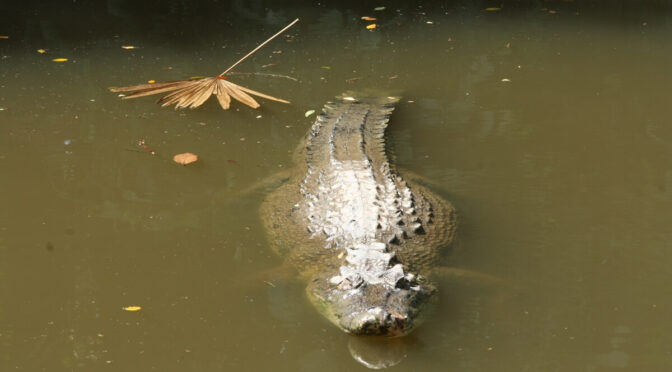Species: Crocodylus porosus (Reptilia : Crocodilia)
Known Range: South Asia to northern Australia
Size: (Adult) 6 m
Interviewed: Wan Nor Fitri Wan Jaafar, wildlife reproduction biologist (wannorfitri[at]gmail.com)
(Photo: Saltwater crocodile by Wan Nor Fitri Wan Jaafar)
IN MANGROVES, the saltwater crocodile claims top predator position.
And this largest of the crocodiles (adults grow more than 7 meters long) doesn’t just live in saltwater, but thrives in rivers and the intertidal zones on the coast.
Crocodylus researcher Fitri says that in Malaysia, wild saltwater crocodiles live in mangroves at Rembau-Linggi by the border of Melaka and Negeri Sembilan, the Setiu-Chalok-Bari basin in Terengganu, and several major riverways in Sabah and Sarawak.
The crocodiles are most easily spotted resting on riverbanks on the edges of mangrove forests. Otherwise, these ambush hunters are submerged and often peek out from just beneath the water.
Saltwater crocodiles are a protected species under the Protection of Wildlife Act 1972, says Fitri. But historically, they have been killed for their skin or because they were perceived as a threat to humans.
When authorities cannot relocate a crocodile of concern, they might be forced to kill the animal, says Fitri.
But such actions come with long-term consequences. Because crocodiles thus killed tend to be the larger adults, we might also be inadvertently removing large individuals from the crocodiles’ gene pool, he says.
But saltwater crocodiles help keep mangrove ecosystems healthy.
As top predators, they keep the numbers of smaller animals in check. And by removing the weak and old prey, they keep the gene pool resilient and healthy.
Crocodiles are also key indicators that help scientists measure environmental pollution. When a predator eats a prey, it could pick up non-digestible toxins in its prey. These toxins accumulate in the food web all the way up to the saltwater crocodiles at the top.
Therefore, the health of saltwater crocodiles reflects the health of the mangrove ecosystems.
Saltwater crocodiles are also threatened by changes in seasonal weather and the microclimate.
The female crocodiles nurture their eggs on riverbank nests. But during the extreme warm weather of the El Nino climate pattern, the females tend to abandon their eggs and leave them unprotected. The females would also flee their nests during floods.
Anticipating exacerbated weather events in the future that might hamper saltwater crocodile breeding, Fitri advises taking precautions like setting up gene banks to preserve the species’ gene pool.
Crocodile farms in the country serve as an excellent resource to store the genetic information of the species, he says.
Fitri emphasises however the importance of maintaining intact natural habitats for the wild saltwater crocodiles to breed and survive well.
Ecotourism can be leveraged as a tool to sustainably manage wild saltwater crocodile populations. A local sightseeing tour of crocodiles might appeal to people who are intrigued by the animal.
If the local communities can be persuaded to appreciate the cultural and economic values of saltwater crocodiles, it could foster a sense of pride and co-living relationship with this top predator of mangroves.
[Edited by YH Law and SL Wong]
Lucy Wong (@lucy_cfc) is a Macaranga Sprouts journalist. We thank the supporters of the Sprouts initiative who made this story possible. Lucy Wong reported for this article during her time in Rimbun Dahan’s Conservation Research Writing Residency.
Further Reading
W-N. Fitri et al. 2018. Digital massage for semen collection, evaluation and extension in Malaysian estuarine crocodile (Crocodylus porosus). Aquaculture 483: 169-172.
R. Hassan et al. 2018. Assessment of wild saltwater crocodile population in bako river, western Sarawak, Malaysian Borneo for potential ecotourism industry. Malaysian Applied Biology 47: 131-138.
A. Britton et al. 2012. Here be a dragon: exceptional size in a saltwater crocodile (Crocodylus porosus) from the Philippines. Herpetological Review 43: 541-546.


